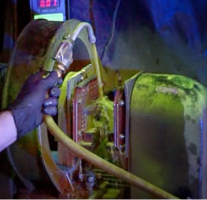Our In-House NDT Testing Capabilities
At American Metal Testing, we specialize in three core non-destructive testing (NDT) services: Fluorescent Penetrant Inspection, Magnetic Particle Inspection, and Radiographic Film Inspection. Each method is performed in-house by our Level I, II, & III technicians to verify the integrity of your components without compromising performance.
We are NADCAP accredited in all three processes and maintain additional certifications for aerospace, defense, manufacturing, and other industrial sectors. Whatever your industry or application, you can rely on AMT to deliver results that meet the most stringent testing standards.
Get NDT Testing Processes for Your Metal Components
Explore the services below to learn more about our in-house NDT testing capabilities. Questions? Contact us to discuss your specific testing needs and project requirements.
Non-Destructive Testing Methods Performed In-House
Fluorescent Penetrant Inspection
When your quality standard requires a surface free from tiny cracks, inclusions, or other defects not visible with a visual inspection, Fluorescent Penetrant Inspection (FPI) makes detection possible on most non-porous materials. The part is cleaned, and a dye suspended in penetrating oil is applied, allowing it to flow into surface imperfections. When our special developer is added, those defects are clearly revealed.
A similar method suspends fluorescent powder in penetrating oil. This brightly colored film covers the parts, and the penetrant finds its way into any defects. The part is dusted with drying powder, and the fluorescent solution is drawn from the defect. A visual inspection is done in an ultraviolet-lighted environment, clearly revealing the defects as they glow.
Generally, dye-penetrant testing techniques identify defects on the surface of the casting and do not detect internal porosity or shrinkage that is not exposed to the surface. However, FPI can detect hairline cracks, rounded indications for porosity, or gas on the casting surface. FPI methods are less expensive than radiographic testing.
Magnetic Particle Inspection
Magnetic particle Inspection (MPI) detects surface and slightly subsurface discontinuities in ferromagnetic materials such as iron, nickel, cobalt, and others made from these alloys. A high-amperage, low-voltage current is passed through the part, which establishes a magnetic field. Magnetic flux is introduced to the part. Since cracks and defects have different magnetic properties than those of the surrounding material, their presence causes distortion by interrupting the magnetic field, thereby indicating the shape and position of the crack or void.
The piece can be magnetized by direct or indirect magnetization. Direct magnetization is when the electric current passes through the part, and a magnetic field is formed in the material. Indirect magnetization is when a magnetic field is applied from an outside source. The magnetic lines of force are perpendicular to the direction of the electric current, which may be either alternating current (AC) or some form of direct current (DC) (rectified AC).
Magnetic particle inspection is quick, inexpensive, and sensitive to particularly shallow (0.003 in.) defects, surface cracks, and other lineal indications.
Radiographic Testing
Radiographic inspection, also known as X-ray metal testing, is the most effective non-destructive method for detecting internal defects and hidden flaws, including shrinkage and inclusions. This process enables us to examine the part using short-wavelength electromagnetic radiation (high-energy photons) that can penetrate various materials. The radiograph serves as a permanent record of the part quality, which can be reviewed by multiple personnel.
With radiographic inspection, a component is exposed to ionizing radiation from an X-ray tube. The component absorbs some of the radiation, and the remaining portion of the radiation exposes the radiographic film. Dense materials can withstand the radiation penetration, so the film is exposed to a lesser degree in those areas, giving the film a lighter appearance. Less dense materials allow more penetration and correlate to darker areas on the film. Any hole, crack, or inclusion that is less dense than the part's alloy is revealed as a dark area.
Casting thickness and density will affect the range of inspection possible, depending on the energy level of the radiation.
NADCAP Accredited NDT Testing Processes
American Metal Testing is NADCAP-accredited for our NDT processes. We also maintain compliance with ASTM standards and other industry certifications to cover a wide range of industrial NDT inspection requirements. Our certifications include:
- NADCAP Accreditation – FPI, MPI, and Radiographic Film
- ASTM International Standards Compliance
- Aerospace Material Specifications (AMS)
- American Society of Mechanical Engineers (ASME)
- Society of Automotive Engineers (SAE)
- American National Standards Institute (ANSI)
- American Welding Society (AWS)
- Military Specifications (MIL)
Learn How AMT Can Prove Your Parts Meet Industry Standards
Contact us today to learn how American Metal Testing can provide you with NADCAP-accredited NDT testing capabilities that comply with ASTM standards. For more information about metal testing, view our Non-Destructive Testing Resource Guide.
With AMT, you can count on our team to maintain the highest quality in all non-destructive testing and failure analysis of metal components, machine parts, and metal casting, ensuring your metal parts are safe, reliable, and free from defects. For all your metal testing needs, trust American Metal Testing.






